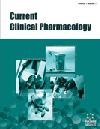- Home
- A-Z Publications
- Current Clinical Pharmacology
- Previous Issues
- Volume 9, Issue 3, 2014
Current Clinical Pharmacology - Volume 9, Issue 3, 2014
Volume 9, Issue 3, 2014
-
-
oa Editorial (Thematic Issue: Development of Natural Products as Anti-Parasitic Agents)
More LessParasites are eukaryotic pathogens and largely include protozoa, helminths and arthropods that cause different diseases to human. Parasitic diseases have a significant impact on developing countries and it has raised the mortality rate to various millions per year. Despite the recent progress, no vaccines are presently available against any of the major parasitic infections of humans. Chemotherapy remains the only o Read More
-
-
-
Plants Used in Traditional Medicine: Extracts and Secondary Metabolites Exhibiting Antileishmanial Activity
More LessPlants and their extracts have been used traditionally against different pathologies, and in some poor regions they are the only therapeutic source for treatments. Moreover, the identification of specific active secondary metabolites can be account for amelioration of clinical status of suffering individual. A series of ethnopharmacological surveys conducted in Brazil recorded the traditional use of plants against different pathologi Read More
-
-
-
An In-Silico Investigation of Anti-Chagas Phytochemicals
More LessAuthors: Stephanie F. McCulley and William N. SetzerOver 18 million people in tropical and subtropical America are afflicted by American trypanosomiasis or Chagas disease. In humans, symptoms of the disease include fever, swelling, and heart and brain damage, usually leading to death. There is currently no effective treatment for this disease. Plant products continue to be rich sources of clinically useful drugs, and the biodiversity of the Neotropics suggests great phytomedicinal Read More
-
-
-
Marine Products with Anti-Protozoal Activity: A Review
More LessAuthors: Marley Garcia and Lianet MonzoteThe marine organisms are a rich source of varied natural products with unique functionality. A variety of natural products of new molecular structures with diverse biological activities have been reported from marine flora and fauna for treatment and/or prevention of human diseases. The present review briefly illustrates current status of marine products as antiprotozoal agents. The in vitro and in vivo studies of marine Read More
-
-
-
In-vivo and In-vitro Activities of Medicinal Plants on Ecto, Endo and Haemoparasitic Infections: A Review
More LessAuthors: Albert Wulari Mbaya and Mathew OgwijiCrude methanol, pet. ether, ethyl acetate, n-hexane, dichloromethane and aqueous extracts of various species of medicinal plants have shown significant in-vivo and in-vitro pharmacological activities against ecto, endo and haemoparasites. The scientific evaluations of the use of the plants as antiparasitic agents were based on the claims of folklore drawn from traditional healers from various communities across the world. Read More
-
-
-
Setting a Colorimetric Assay with MTT for Assessment of Trichomonicidal Activity
More LessAuthors: Idalia Sariego, Lianet Monzote and Lazara RojasTrichomonas vaginalis infection is associated with important problems of public health, including the spreading of other sexual transmitted infections. The existence of clinical resistant isolates metronidazole and tinidazole, the drugs approved for the treatment of trichomoniasis, points to the necessity of continue searching for trichomonicidal substances. Here we optimize a colorimetric assay with MTT to assess trichom Read More
-
-
-
Alternative Approach for Mitigation of Doxorubicin-Induced Cardiotoxicity using Herbal Agents
More LessAuthors: Mohammad Ahmed Khan, Mhaveer Singh, Masood Shah Khan, Wasim Ahmad, Abul Kalam Najmi and Sayeed AhmadDoxorubicin (DOX) is an effective and frequently used chemotherapeutic agent for various malignancies. However, its clinical use is hampered due to the development of cardiotoxicity. Investigations have proved that DOXinduced cardiotoxicity occurs through mechanisms other than those mediating its antitumor effect. This theory sheds light on the development of strategies for cardioprotection without altering therapeutic Read More
-
-
-
Cardiotonic Steroids in Adaptation to Dietary Salt Intake
More LessAuthors: Larry Dial, Jiang Liu and Joseph I. ShapiroFor many years the concept relating salt to blood pressure (BP) changes has been debated and the concept of natriuretic hormone eliminating excessive sodium by direct inhibition of Na/K-ATPase has raised controversy. However, a recently discovered Na/K-ATPase signaling function has been widely confirmed and provided a novel mechanism to explain the relationship between sodium and blood pressure. Recently, we h Read More
-
-
-
The Pharmacokinetics of Long-Acting Antipsychotic Medications
More LessAuthors: Stefano Spanarello and Teresa La FerlaThe depot antipsychotics are synthesized by esterification of the active drug to a long chain fatty acid and the resultant compound is then dissolved in a vegetable oil, with the exception of some molecules of new generation characterized by microcrystalline technologies. The absorption rate constant is slower than the elimination rate constant and therefore, the depot antipsychotics exhibit 'flip-flop' kinetics where the time to Read More
-
Volumes & issues
Most Read This Month
Article
content/journals/ccp
Journal
10
5
false
en


